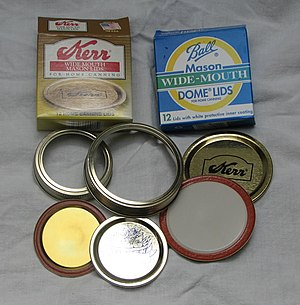Talk:Mason jar
| This article is rated Start-class on Wikipedia's content assessment scale. It is of interest to the following WikiProjects: | |||||||||||||||||||||||||||||||
| |||||||||||||||||||||||||||||||
Merger[edit]
I propose merging this page with antique fruit jar—Preceding unsigned comment added by FiveRings (talk • contribs) 20:57, 26 March 2008
- There was no support for the proposal, since "Mason jars" are still manufactured. Edison (talk) 02:11, 23 November 2008 (UTC)
Band[edit]
I removed text claiming the screw-on band could produce a vacuum seal. The function of the band is merely to hold the lid in place while the jar and contents boil initially. Once the rubber under the lid has formed a vacuum seal, the band has no need to remain and can be removed, per the Ball Company instruction manual for canning. The band does not cover the top of the jar and could in no way form any sort of seal. Edison (talk) 02:11, 23 November 2008 (UTC)
Improvised bomb[edit]
I added a template showing that a reference was needed for the claim that in Vietnam the jars were used as improvised aerial bombs, by pulling the pin of a hand grenade, placing the grenade in a mason jar, then dropping it from a helicopter. That would doubtless work, since when it hit the ground and the jar broke, the handle would be released to fly up, whereupon the grenade would kill people near it on the ground. But such a claim needs a reliable source to satisfy verifiability. One argument against it is that if the jar rolled across the floor of a helo, it could break in the aircraft, and the grenade would kill everyone on board. It is thus less secure and more dangerous to the aviators than even small aerial bombs used in World War One, which had an arming mechanism whereby a little propeller had to rotate many times before the detonator was armed. If there was a need for small aerial bombs, there were safer (for the dropper) ones than this. No ref was provided, so I removed the section, which is more related to the Vietnam War than to the Mason jar article. Edison (talk) 16:50, 15 February 2011 (UTC)
removal[edit]
I removed "Some old Mason jars used glass lids with separate rubber rings, instead of steel, and are now considered unsafe for canning.[citation needed]" as glass lid canning jars are still manufactured and are considered safe. Most antique glass lid canning jars are also safe.Mrs269 (talk) 03:53, 5 February 2014 (UTC)
Drinking[edit]
Needs coverage expanded on their use as drinking vessels (traditional US) and the modern hipster version, where Mason jar mugs are now made, with moulded on handles (and still with the screw threads). Such preservation of a now pointless sealing feature might even be seen as skeumorphism. Andy Dingley (talk) 17:16, 25 August 2015 (UTC)
cloth covering?[edit]
I would like to know what is the origin of the practice of covering a finished canning jar with a cloth covering wrapped in string? It seems purely decorative now, but I think it originally had a purpose as a means of sealing the jar. The best reference I could find on this practice is from 'The Country Gentleman', 1896, Vol 16 page 417: '...To prevent preserves from spoiling, apply the white of an egg to a single thickness of white paper, with which cover the jars, lapping over an inch or so. It will need no tying, becoming when dry hermetically tight and strong...' My guess is the cloth cover is now just a qwerty phenomenon.
https://books.google.com/books?id=4-IxAQAAMAAJ&pg=PA417&dq=canning+jar+cover+fabric&hl=en&sa=X&ved=0ahUKEwjRwPShurLKAhVMzGMKHT-BCTQQ6AEITjAG#v=onepage&q=canning%20jar%20cover%20fabric&f=false — Preceding unsigned comment added by Slashdottir (talk • contribs) 04:07, 18 January 2016 (UTC)
So WHO is making them in the USA?[edit]
I came here to find out WHO is making Mason / Kerr / Ball canning jars in the USA in the year 2016 and was sadly disappointed in this article, which ends with nothing more than obfuscation.Starhistory22 (talk) 22:18, 23 November 2016 (UTC)
- Jardin Corporation makes both Ball and Kerr.
Hipsters[edit]
Hipsters now drink from Mason jars.
Thread Sizes?[edit]
What are the specifications for the cap threads? There must be a standard or convention because lids and bottles are interchangeable between brands and over time. — Preceding unsigned comment added by 47.218.189.187 (talk) 04:26, 29 October 2019 (UTC)
Uncited material in need of citations[edit]
I am moving the following uncited material here until it can be properly supported with inline citations of reliable, secondary sources, per WP:V, WP:CS, WP:IRS, WP:PSTS, WP:BLP, WP:NOR, et al. This diff shows where it was in the article. Nightscream (talk) 19:23, 22 January 2022 (UTC)
Extended content
|
|---|
|
I question this section's objectivity.[edit]
Apologies if this is the wrong place for this, but this quote seems wholly opinionated while using the voice of Wikipedia:
" In a search for authenticity, commodification of Mason jars occurred leading to irony, as drinking out of canning jar highlighted overconsumption and lack of scarcity, the opposite of the designed intention of the jars. "
Not only is this nonobjective, as irony isn't quantifiable, it's source is a page that 404's. It is my understanding this is against the rules about having a NPOV. BrowserKitty (talk) 20:48, 3 March 2024 (UTC)
- Articles with conflicting quality ratings
- C-Class glass articles
- Unknown-importance glass articles
- C-Class glass articles of Unknown-importance
- WikiProject Glass articles
- Start-Class Containers articles
- Start-Class Indiana Historical Society articles
- Low-importance Indiana Historical Society articles
- WikiProject Indiana Historical Society articles

